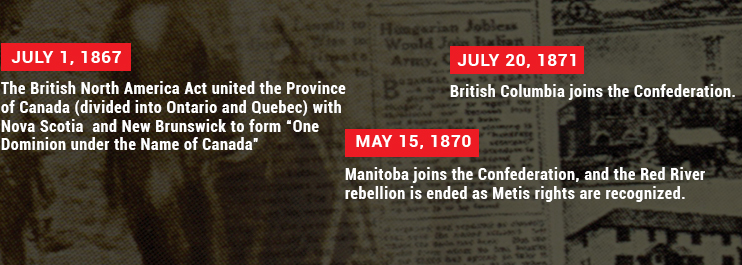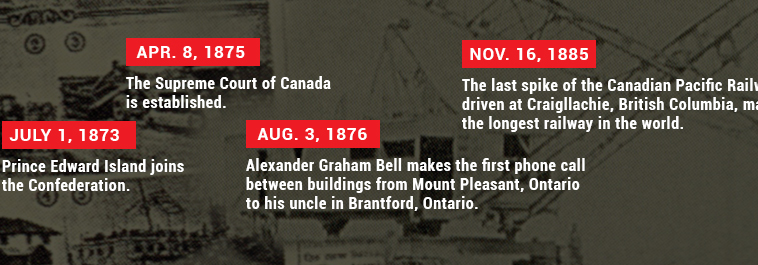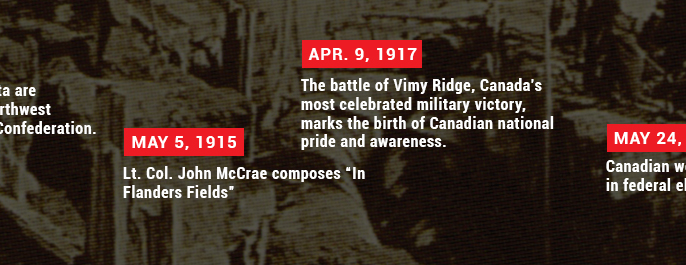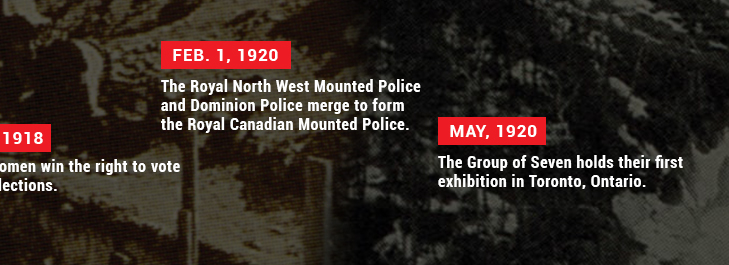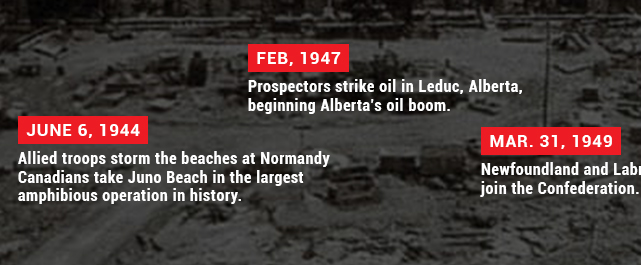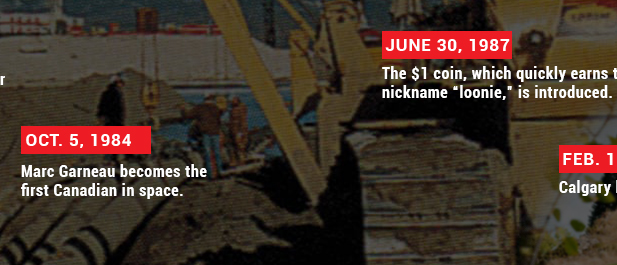The Coril Group of Companies is proud to celebrate Canada’s 150th Anniversary.
The Mannix family businesses have been in operation since 1898.
1862
George C. Mannix
 George Charles Mannix, Irish immigrant whose legacy would indelibly mark the Canadian landscape and play a crucial role in the early development of Canada.
George Charles Mannix, Irish immigrant whose legacy would indelibly mark the Canadian landscape and play a crucial role in the early development of Canada.
 George Charles Mannix, Irish immigrant whose legacy would indelibly mark the Canadian landscape and play a crucial role in the early development of Canada.
George Charles Mannix, Irish immigrant whose legacy would indelibly mark the Canadian landscape and play a crucial role in the early development of Canada.
1869 - 1870
The Red River Expedition
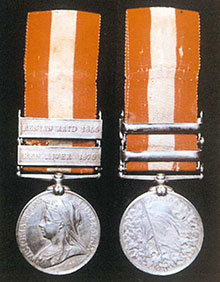 George Charles Mannix served in the Fenian Raids of 1866 and the Red River Rebellion of 1869-70. He was one of the few people awarded medals for both services. After the Red River Expedition brought him west, G.C. Mannix settled in Manitoba. For service rendered in the Red River Expedition, he was awarded the right to choose a quarter section (160 acres/65 hectares) of land.
George Charles Mannix served in the Fenian Raids of 1866 and the Red River Rebellion of 1869-70. He was one of the few people awarded medals for both services. After the Red River Expedition brought him west, G.C. Mannix settled in Manitoba. For service rendered in the Red River Expedition, he was awarded the right to choose a quarter section (160 acres/65 hectares) of land.
 George Charles Mannix served in the Fenian Raids of 1866 and the Red River Rebellion of 1869-70. He was one of the few people awarded medals for both services. After the Red River Expedition brought him west, G.C. Mannix settled in Manitoba. For service rendered in the Red River Expedition, he was awarded the right to choose a quarter section (160 acres/65 hectares) of land.
George Charles Mannix served in the Fenian Raids of 1866 and the Red River Rebellion of 1869-70. He was one of the few people awarded medals for both services. After the Red River Expedition brought him west, G.C. Mannix settled in Manitoba. For service rendered in the Red River Expedition, he was awarded the right to choose a quarter section (160 acres/65 hectares) of land.
1881
Frederick Stephen Mannix
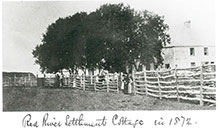 Frederick Stephen Mannix is born at the Red River Settlement in Manitoba.
Frederick Stephen Mannix is born at the Red River Settlement in Manitoba.
 Frederick Stephen Mannix is born at the Red River Settlement in Manitoba.
Frederick Stephen Mannix is born at the Red River Settlement in Manitoba.
1898
The First Mannix Company
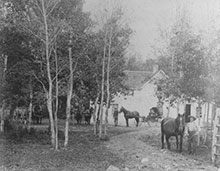 F.S. Mannix bought a slip and a team of horses for $150 and went to work on the railway. From this first earthmoving job, Frederick eventually formed one of Canada’s largest heavy construction firms and diversified into other industries.
F.S. Mannix bought a slip and a team of horses for $150 and went to work on the railway. From this first earthmoving job, Frederick eventually formed one of Canada’s largest heavy construction firms and diversified into other industries.
 F.S. Mannix bought a slip and a team of horses for $150 and went to work on the railway. From this first earthmoving job, Frederick eventually formed one of Canada’s largest heavy construction firms and diversified into other industries.
F.S. Mannix bought a slip and a team of horses for $150 and went to work on the railway. From this first earthmoving job, Frederick eventually formed one of Canada’s largest heavy construction firms and diversified into other industries.
1907
Connecting Alberta and Saskatchewan
 F.S Mannix' crews begin a multi-year project building rail grade between Unity, Saskatchewan, and Hardisty, Alberta.
F.S Mannix' crews begin a multi-year project building rail grade between Unity, Saskatchewan, and Hardisty, Alberta.
 F.S Mannix' crews begin a multi-year project building rail grade between Unity, Saskatchewan, and Hardisty, Alberta.
F.S Mannix' crews begin a multi-year project building rail grade between Unity, Saskatchewan, and Hardisty, Alberta.
1911
The Brooks Irrigation System
 Described as the largest dirt-moving contract ever let in Alberta, the irrigation system at Brooks, east of Bassano, is built by F.S Mannix and his crew. The system provides water for 200,000 acres of farmland that otherwise might have been too dry for agriculture. Irrigation projects such as this one helped to encourage settlement in the western provinces.
Described as the largest dirt-moving contract ever let in Alberta, the irrigation system at Brooks, east of Bassano, is built by F.S Mannix and his crew. The system provides water for 200,000 acres of farmland that otherwise might have been too dry for agriculture. Irrigation projects such as this one helped to encourage settlement in the western provinces.
 Described as the largest dirt-moving contract ever let in Alberta, the irrigation system at Brooks, east of Bassano, is built by F.S Mannix and his crew. The system provides water for 200,000 acres of farmland that otherwise might have been too dry for agriculture. Irrigation projects such as this one helped to encourage settlement in the western provinces.
Described as the largest dirt-moving contract ever let in Alberta, the irrigation system at Brooks, east of Bassano, is built by F.S Mannix and his crew. The system provides water for 200,000 acres of farmland that otherwise might have been too dry for agriculture. Irrigation projects such as this one helped to encourage settlement in the western provinces.
1925
The Settlement of the Prairies
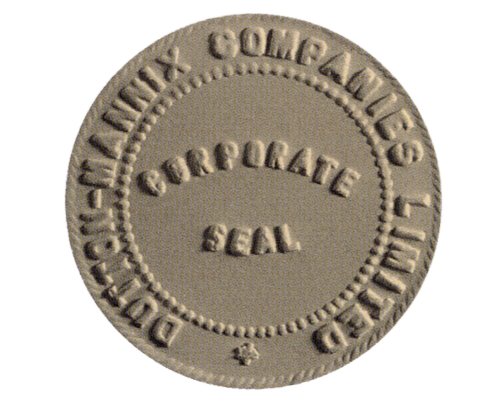 F.S Mannix formed a joint venture with longtime dirt mover W.A Dutton form Dutton-Mannix Companies Limited. An early job is the CPR branch line on the Alberta-Saskatchewan border. During this time, railways were an essential component of progressive settlement in the Prairies.
F.S Mannix formed a joint venture with longtime dirt mover W.A Dutton form Dutton-Mannix Companies Limited. An early job is the CPR branch line on the Alberta-Saskatchewan border. During this time, railways were an essential component of progressive settlement in the Prairies.
 F.S Mannix formed a joint venture with longtime dirt mover W.A Dutton form Dutton-Mannix Companies Limited. An early job is the CPR branch line on the Alberta-Saskatchewan border. During this time, railways were an essential component of progressive settlement in the Prairies.
F.S Mannix formed a joint venture with longtime dirt mover W.A Dutton form Dutton-Mannix Companies Limited. An early job is the CPR branch line on the Alberta-Saskatchewan border. During this time, railways were an essential component of progressive settlement in the Prairies.
1926
Steam Dragline
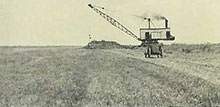 First steam dragline purchased by the Mannix company. This steam dragline is used for several years on the drainage project in Morris, Manitoba.
First steam dragline purchased by the Mannix company. This steam dragline is used for several years on the drainage project in Morris, Manitoba.
 First steam dragline purchased by the Mannix company. This steam dragline is used for several years on the drainage project in Morris, Manitoba.
First steam dragline purchased by the Mannix company. This steam dragline is used for several years on the drainage project in Morris, Manitoba.
1928
Development of Northern Alberta
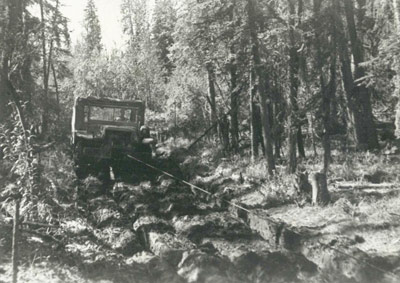 Continuing to help develop northern Alberta, Mannix crews lay rail bed near Slave Lake-an area known for muskeg.
Continuing to help develop northern Alberta, Mannix crews lay rail bed near Slave Lake-an area known for muskeg.
 Continuing to help develop northern Alberta, Mannix crews lay rail bed near Slave Lake-an area known for muskeg.
Continuing to help develop northern Alberta, Mannix crews lay rail bed near Slave Lake-an area known for muskeg.
1934
Coal Mining in Western Canada - Dirty thirties
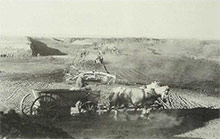 Early in 1934, Mannix & Kramer reactivated their company and headed off for Sheerness with new teams of horses, an elevating grader, several Cats, and new Euclid crawler wagons outfitted with tracks. The event brought the company back to life. From the first small stripping contract at the Sheerness mine, the Mannix organization played a leading role in the development of surface and open-pit coal mining in Western Canada.
Early in 1934, Mannix & Kramer reactivated their company and headed off for Sheerness with new teams of horses, an elevating grader, several Cats, and new Euclid crawler wagons outfitted with tracks. The event brought the company back to life. From the first small stripping contract at the Sheerness mine, the Mannix organization played a leading role in the development of surface and open-pit coal mining in Western Canada.
 Early in 1934, Mannix & Kramer reactivated their company and headed off for Sheerness with new teams of horses, an elevating grader, several Cats, and new Euclid crawler wagons outfitted with tracks. The event brought the company back to life. From the first small stripping contract at the Sheerness mine, the Mannix organization played a leading role in the development of surface and open-pit coal mining in Western Canada.
Early in 1934, Mannix & Kramer reactivated their company and headed off for Sheerness with new teams of horses, an elevating grader, several Cats, and new Euclid crawler wagons outfitted with tracks. The event brought the company back to life. From the first small stripping contract at the Sheerness mine, the Mannix organization played a leading role in the development of surface and open-pit coal mining in Western Canada.
1935
Connecting Golden and Radium B.C.
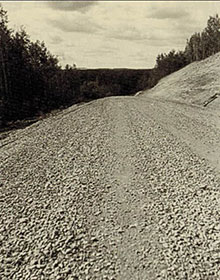 The fall of the year sees F.C. Mannix running three road construction jobs on Highway No. 95 along the Columbian River between Golden and Radium, British Columbia.
The fall of the year sees F.C. Mannix running three road construction jobs on Highway No. 95 along the Columbian River between Golden and Radium, British Columbia.
 The fall of the year sees F.C. Mannix running three road construction jobs on Highway No. 95 along the Columbian River between Golden and Radium, British Columbia.
The fall of the year sees F.C. Mannix running three road construction jobs on Highway No. 95 along the Columbian River between Golden and Radium, British Columbia.
1936
Eastern Canada Expansion
 Fred Mannix & Company, Ltd. is awarded the contract to build a Canadian National rail line from Senneterre to Rouyn, Quebec (the Val-d’Or Railway). This 100-mile (160-kilometer) project, more than 1,200 miles (2,000 kilometer) from Calgary, is the company’s first expansion into eastern Canada.
Fred Mannix & Company, Ltd. is awarded the contract to build a Canadian National rail line from Senneterre to Rouyn, Quebec (the Val-d’Or Railway). This 100-mile (160-kilometer) project, more than 1,200 miles (2,000 kilometer) from Calgary, is the company’s first expansion into eastern Canada.
 Fred Mannix & Company, Ltd. is awarded the contract to build a Canadian National rail line from Senneterre to Rouyn, Quebec (the Val-d’Or Railway). This 100-mile (160-kilometer) project, more than 1,200 miles (2,000 kilometer) from Calgary, is the company’s first expansion into eastern Canada.
Fred Mannix & Company, Ltd. is awarded the contract to build a Canadian National rail line from Senneterre to Rouyn, Quebec (the Val-d’Or Railway). This 100-mile (160-kilometer) project, more than 1,200 miles (2,000 kilometer) from Calgary, is the company’s first expansion into eastern Canada.
1941
Supporting the War Effort
 In January, F.S Mannix contracts with Calgary Power to construct the Cascade hydroelectric project, including the Minnewanka Dam, by the spring of 1942. This was considered an important war project (World War II) because its main purpose was to supply the electric power requirements for the manufacture of explosives needed for the war effort.
In January, F.S Mannix contracts with Calgary Power to construct the Cascade hydroelectric project, including the Minnewanka Dam, by the spring of 1942. This was considered an important war project (World War II) because its main purpose was to supply the electric power requirements for the manufacture of explosives needed for the war effort.
 In January, F.S Mannix contracts with Calgary Power to construct the Cascade hydroelectric project, including the Minnewanka Dam, by the spring of 1942. This was considered an important war project (World War II) because its main purpose was to supply the electric power requirements for the manufacture of explosives needed for the war effort.
In January, F.S Mannix contracts with Calgary Power to construct the Cascade hydroelectric project, including the Minnewanka Dam, by the spring of 1942. This was considered an important war project (World War II) because its main purpose was to supply the electric power requirements for the manufacture of explosives needed for the war effort.
1943
The Kananaskis Dam
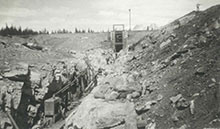 Mannix crews complete the Kananaskis Dam in May. The dam is located in the rugged western Alberta Rocky Mountains. It was important to the Province of Alberta because it controlled the waters feeding the Kananaskis drainage basin as well as the Barrier, Horse Shoe and Ghost power plants.
Mannix crews complete the Kananaskis Dam in May. The dam is located in the rugged western Alberta Rocky Mountains. It was important to the Province of Alberta because it controlled the waters feeding the Kananaskis drainage basin as well as the Barrier, Horse Shoe and Ghost power plants.
 Mannix crews complete the Kananaskis Dam in May. The dam is located in the rugged western Alberta Rocky Mountains. It was important to the Province of Alberta because it controlled the waters feeding the Kananaskis drainage basin as well as the Barrier, Horse Shoe and Ghost power plants.
Mannix crews complete the Kananaskis Dam in May. The dam is located in the rugged western Alberta Rocky Mountains. It was important to the Province of Alberta because it controlled the waters feeding the Kananaskis drainage basin as well as the Barrier, Horse Shoe and Ghost power plants.
1945
Building the Longest Highway in B.C.
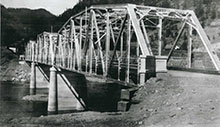 The Hart Highway introduces innovations in road construction including the use of prefabricated bridges. These bridges were a wartime development integrated into civilian construction by Mannix crews. The Hart Hightway is a 405 km long stretch of what is now Highway 97 – the longest continuously numbered highway in British Columbia.
The Hart Highway introduces innovations in road construction including the use of prefabricated bridges. These bridges were a wartime development integrated into civilian construction by Mannix crews. The Hart Hightway is a 405 km long stretch of what is now Highway 97 – the longest continuously numbered highway in British Columbia.
 The Hart Highway introduces innovations in road construction including the use of prefabricated bridges. These bridges were a wartime development integrated into civilian construction by Mannix crews. The Hart Hightway is a 405 km long stretch of what is now Highway 97 – the longest continuously numbered highway in British Columbia.
The Hart Highway introduces innovations in road construction including the use of prefabricated bridges. These bridges were a wartime development integrated into civilian construction by Mannix crews. The Hart Hightway is a 405 km long stretch of what is now Highway 97 – the longest continuously numbered highway in British Columbia.
1946
Building a World Famous Highway
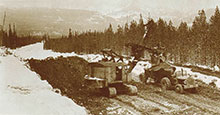 Continuing to expand their constructing expertise in the Alberta Mountains, the Mannix crew builds the world famous Banff to Windermere Highway.
Continuing to expand their constructing expertise in the Alberta Mountains, the Mannix crew builds the world famous Banff to Windermere Highway.
 Continuing to expand their constructing expertise in the Alberta Mountains, the Mannix crew builds the world famous Banff to Windermere Highway.
Continuing to expand their constructing expertise in the Alberta Mountains, the Mannix crew builds the world famous Banff to Windermere Highway.
1946
Venture into Coal
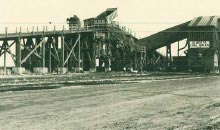 Fred C. Mannix's first wager on the future of coal mining in Western Canada was a small one. In 1946, when the work for the wartime Emergency Coal Production Board came to an end, Mannix acquired the leases for the Majestic Mine at Taber. Mannix then established a subsidiary to own the Majestic Mine, as Morrison-Knudsen had no interest in being directly involved in the acquisition of any coal properties. This new company, Southern Alberta Coal Company Ltd., was incorporated in 1946.
Fred C. Mannix's first wager on the future of coal mining in Western Canada was a small one. In 1946, when the work for the wartime Emergency Coal Production Board came to an end, Mannix acquired the leases for the Majestic Mine at Taber. Mannix then established a subsidiary to own the Majestic Mine, as Morrison-Knudsen had no interest in being directly involved in the acquisition of any coal properties. This new company, Southern Alberta Coal Company Ltd., was incorporated in 1946.
 Fred C. Mannix's first wager on the future of coal mining in Western Canada was a small one. In 1946, when the work for the wartime Emergency Coal Production Board came to an end, Mannix acquired the leases for the Majestic Mine at Taber. Mannix then established a subsidiary to own the Majestic Mine, as Morrison-Knudsen had no interest in being directly involved in the acquisition of any coal properties. This new company, Southern Alberta Coal Company Ltd., was incorporated in 1946.
Fred C. Mannix's first wager on the future of coal mining in Western Canada was a small one. In 1946, when the work for the wartime Emergency Coal Production Board came to an end, Mannix acquired the leases for the Majestic Mine at Taber. Mannix then established a subsidiary to own the Majestic Mine, as Morrison-Knudsen had no interest in being directly involved in the acquisition of any coal properties. This new company, Southern Alberta Coal Company Ltd., was incorporated in 1946.
1946
Providing Power for the Yellowknife District
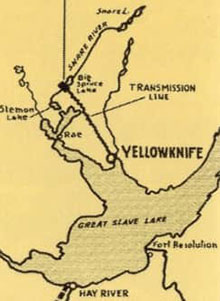 Fred Mannix & Company, Ltd. builds the Snare River hydroelectric power development. The project is northwest of Yellowknife, Northwest Territories. It was considered an important part of the post-war development of the Northwest Territories because it provided power for the mines of the Yellowknife District.
Fred Mannix & Company, Ltd. builds the Snare River hydroelectric power development. The project is northwest of Yellowknife, Northwest Territories. It was considered an important part of the post-war development of the Northwest Territories because it provided power for the mines of the Yellowknife District.
 Fred Mannix & Company, Ltd. builds the Snare River hydroelectric power development. The project is northwest of Yellowknife, Northwest Territories. It was considered an important part of the post-war development of the Northwest Territories because it provided power for the mines of the Yellowknife District.
Fred Mannix & Company, Ltd. builds the Snare River hydroelectric power development. The project is northwest of Yellowknife, Northwest Territories. It was considered an important part of the post-war development of the Northwest Territories because it provided power for the mines of the Yellowknife District.
1948
The Klondike Highway
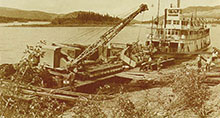 In April, Mannix crew tackles the Yukon wilderness between Whitehorse and Mayo. They build the Klondike Highway. Supplies are brought in by boat.
In April, Mannix crew tackles the Yukon wilderness between Whitehorse and Mayo. They build the Klondike Highway. Supplies are brought in by boat.
 In April, Mannix crew tackles the Yukon wilderness between Whitehorse and Mayo. They build the Klondike Highway. Supplies are brought in by boat.
In April, Mannix crew tackles the Yukon wilderness between Whitehorse and Mayo. They build the Klondike Highway. Supplies are brought in by boat.
1950
Canada's First Major Pipeline Project
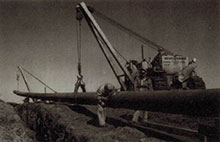 In a joint venture known as Bechtel-Mannix, Mannix crews build the Interprovincial Pipeline from Hardisty, Alberta, to Regina, Saskatchewan. This pipeline represented the first pipeline of the type and size in Canadian history.
In a joint venture known as Bechtel-Mannix, Mannix crews build the Interprovincial Pipeline from Hardisty, Alberta, to Regina, Saskatchewan. This pipeline represented the first pipeline of the type and size in Canadian history.
 In a joint venture known as Bechtel-Mannix, Mannix crews build the Interprovincial Pipeline from Hardisty, Alberta, to Regina, Saskatchewan. This pipeline represented the first pipeline of the type and size in Canadian history.
In a joint venture known as Bechtel-Mannix, Mannix crews build the Interprovincial Pipeline from Hardisty, Alberta, to Regina, Saskatchewan. This pipeline represented the first pipeline of the type and size in Canadian history.
1950
The Largest Construction Project in North America
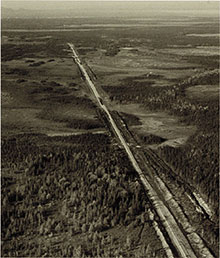 The Quebec, North Shore and Labrador railroad is constructed by Mannix & Co. Ltd. to transport ore from a large mine owned by the Iron Ore Company of Canada. At the time, the project was the largest railway construction job in Canada in a decade and the largest construction project of any kind in North America in the early 1950s.
The Quebec, North Shore and Labrador railroad is constructed by Mannix & Co. Ltd. to transport ore from a large mine owned by the Iron Ore Company of Canada. At the time, the project was the largest railway construction job in Canada in a decade and the largest construction project of any kind in North America in the early 1950s.
 The Quebec, North Shore and Labrador railroad is constructed by Mannix & Co. Ltd. to transport ore from a large mine owned by the Iron Ore Company of Canada. At the time, the project was the largest railway construction job in Canada in a decade and the largest construction project of any kind in North America in the early 1950s.
The Quebec, North Shore and Labrador railroad is constructed by Mannix & Co. Ltd. to transport ore from a large mine owned by the Iron Ore Company of Canada. At the time, the project was the largest railway construction job in Canada in a decade and the largest construction project of any kind in North America in the early 1950s.
1951
Supporting Industiral Growth in Canada
 Mannix Ltd. begins the earth-filled hydroelectric Chutes des Georges Dam located on the Shipshaw River north of Chicoutimi, Quebec. The dam was needed to provide a new source of hydroelectric power to the mushrooming Canadian cities and industry.
Mannix Ltd. begins the earth-filled hydroelectric Chutes des Georges Dam located on the Shipshaw River north of Chicoutimi, Quebec. The dam was needed to provide a new source of hydroelectric power to the mushrooming Canadian cities and industry.
 Mannix Ltd. begins the earth-filled hydroelectric Chutes des Georges Dam located on the Shipshaw River north of Chicoutimi, Quebec. The dam was needed to provide a new source of hydroelectric power to the mushrooming Canadian cities and industry.
Mannix Ltd. begins the earth-filled hydroelectric Chutes des Georges Dam located on the Shipshaw River north of Chicoutimi, Quebec. The dam was needed to provide a new source of hydroelectric power to the mushrooming Canadian cities and industry.
1951
Canada's First Subway System
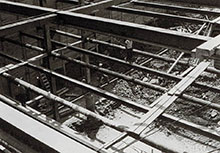 Mannix Ltd. sponsors a joint venture with McNamara Construction to construct the Toronto Subway – Canada’s first subway system. Working below busy downtown Toronto streets creates new challenges.
Mannix Ltd. sponsors a joint venture with McNamara Construction to construct the Toronto Subway – Canada’s first subway system. Working below busy downtown Toronto streets creates new challenges.
 Mannix Ltd. sponsors a joint venture with McNamara Construction to construct the Toronto Subway – Canada’s first subway system. Working below busy downtown Toronto streets creates new challenges.
Mannix Ltd. sponsors a joint venture with McNamara Construction to construct the Toronto Subway – Canada’s first subway system. Working below busy downtown Toronto streets creates new challenges.
1952
Building the Trans-Canada Highway
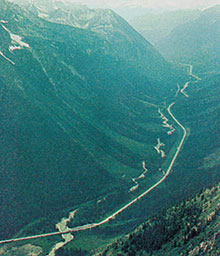 Federal and provincial governments decide to build a major coast-to-coast highway. Mannix Ltd. begins to work on one of many Trans-Canada Highway projects – a highway which extends through all ten provinces of Canada.
Federal and provincial governments decide to build a major coast-to-coast highway. Mannix Ltd. begins to work on one of many Trans-Canada Highway projects – a highway which extends through all ten provinces of Canada.
 Federal and provincial governments decide to build a major coast-to-coast highway. Mannix Ltd. begins to work on one of many Trans-Canada Highway projects – a highway which extends through all ten provinces of Canada.
Federal and provincial governments decide to build a major coast-to-coast highway. Mannix Ltd. begins to work on one of many Trans-Canada Highway projects – a highway which extends through all ten provinces of Canada.
1952
Expansion Regardless of the Obstacles
 Mannix Ltd. pipeliners build the Trans-Northern Pipeline Co. spur line to Ottawa. This $4-million project involves 11 major crossings including the Rideau River and the Burlington Canal.
Mannix Ltd. pipeliners build the Trans-Northern Pipeline Co. spur line to Ottawa. This $4-million project involves 11 major crossings including the Rideau River and the Burlington Canal.
 Mannix Ltd. pipeliners build the Trans-Northern Pipeline Co. spur line to Ottawa. This $4-million project involves 11 major crossings including the Rideau River and the Burlington Canal.
Mannix Ltd. pipeliners build the Trans-Northern Pipeline Co. spur line to Ottawa. This $4-million project involves 11 major crossings including the Rideau River and the Burlington Canal.
1952
Construction in a Harsh Quebec Winter
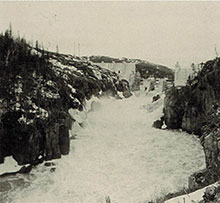 Mannix Ltd. crew is close to completing the Marguerite Dam west of Sept-îles. They will work through the harsh Quebec winter to ensure the concrete spillway is ready for the 1953 runoff.
Mannix Ltd. crew is close to completing the Marguerite Dam west of Sept-îles. They will work through the harsh Quebec winter to ensure the concrete spillway is ready for the 1953 runoff.
 Mannix Ltd. crew is close to completing the Marguerite Dam west of Sept-îles. They will work through the harsh Quebec winter to ensure the concrete spillway is ready for the 1953 runoff.
Mannix Ltd. crew is close to completing the Marguerite Dam west of Sept-îles. They will work through the harsh Quebec winter to ensure the concrete spillway is ready for the 1953 runoff.
1952
The Menihek Dam
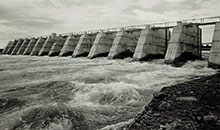 Far north in Laborador, Mannix crews begin the Menihek Dam that will provide power to the iron ore mine and provide a bridge for the QNS&L Railway across the Ashuanipi River.
Far north in Laborador, Mannix crews begin the Menihek Dam that will provide power to the iron ore mine and provide a bridge for the QNS&L Railway across the Ashuanipi River.
 Far north in Laborador, Mannix crews begin the Menihek Dam that will provide power to the iron ore mine and provide a bridge for the QNS&L Railway across the Ashuanipi River.
Far north in Laborador, Mannix crews begin the Menihek Dam that will provide power to the iron ore mine and provide a bridge for the QNS&L Railway across the Ashuanipi River.
1952
The Niagara Tunnel Project for Ontario Hydro
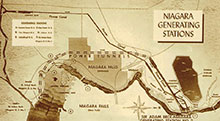 In an international joint venture, Mannix Ltd. helps building the Niagara Tunnels, a part of the Sir Adam Beck-Niagara Generating Station No. 2 project for Ontario Hydro.
In an international joint venture, Mannix Ltd. helps building the Niagara Tunnels, a part of the Sir Adam Beck-Niagara Generating Station No. 2 project for Ontario Hydro.
 In an international joint venture, Mannix Ltd. helps building the Niagara Tunnels, a part of the Sir Adam Beck-Niagara Generating Station No. 2 project for Ontario Hydro.
In an international joint venture, Mannix Ltd. helps building the Niagara Tunnels, a part of the Sir Adam Beck-Niagara Generating Station No. 2 project for Ontario Hydro.
1952
Providing Energy to the West Coast
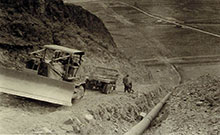 Mannix-O’Sullivan crews help building the Trans Mountain oil pipeline near Kamloops, British Columbia. In operation since 1953, the Trans Mountain pipeline system (TMPL) is the only pipeline system in North America that transports both crude oil and refined products to the west coast.
Mannix-O’Sullivan crews help building the Trans Mountain oil pipeline near Kamloops, British Columbia. In operation since 1953, the Trans Mountain pipeline system (TMPL) is the only pipeline system in North America that transports both crude oil and refined products to the west coast.
 Mannix-O’Sullivan crews help building the Trans Mountain oil pipeline near Kamloops, British Columbia. In operation since 1953, the Trans Mountain pipeline system (TMPL) is the only pipeline system in North America that transports both crude oil and refined products to the west coast.
Mannix-O’Sullivan crews help building the Trans Mountain oil pipeline near Kamloops, British Columbia. In operation since 1953, the Trans Mountain pipeline system (TMPL) is the only pipeline system in North America that transports both crude oil and refined products to the west coast.
1953
A Nova Scotia Wharf is Revitalized
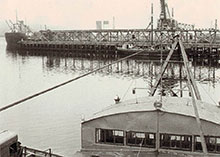 A view over the Miss Mannix in Port Maitland, Nova Scotia. This is early work on the new steel sheet piling wharf that will replace the federal government’s old wooden wharf ensuring the longevity of the port.
A view over the Miss Mannix in Port Maitland, Nova Scotia. This is early work on the new steel sheet piling wharf that will replace the federal government’s old wooden wharf ensuring the longevity of the port.
 A view over the Miss Mannix in Port Maitland, Nova Scotia. This is early work on the new steel sheet piling wharf that will replace the federal government’s old wooden wharf ensuring the longevity of the port.
A view over the Miss Mannix in Port Maitland, Nova Scotia. This is early work on the new steel sheet piling wharf that will replace the federal government’s old wooden wharf ensuring the longevity of the port.
1954
An Engineering Marvel
 One of the engineering marvels of the 1950s occurs with the cooperation between Canada and the United States. The St. Lawrence Seaway requires several large construction projects and opened the Great Lakes region to the oceangoing fleets of the entire world. Completed by Mannix Ltd., the seaway had a major economic impact on Canada, providing economical freight rates for bulk commodities.
One of the engineering marvels of the 1950s occurs with the cooperation between Canada and the United States. The St. Lawrence Seaway requires several large construction projects and opened the Great Lakes region to the oceangoing fleets of the entire world. Completed by Mannix Ltd., the seaway had a major economic impact on Canada, providing economical freight rates for bulk commodities.
 One of the engineering marvels of the 1950s occurs with the cooperation between Canada and the United States. The St. Lawrence Seaway requires several large construction projects and opened the Great Lakes region to the oceangoing fleets of the entire world. Completed by Mannix Ltd., the seaway had a major economic impact on Canada, providing economical freight rates for bulk commodities.
One of the engineering marvels of the 1950s occurs with the cooperation between Canada and the United States. The St. Lawrence Seaway requires several large construction projects and opened the Great Lakes region to the oceangoing fleets of the entire world. Completed by Mannix Ltd., the seaway had a major economic impact on Canada, providing economical freight rates for bulk commodities.
1954
Incorporated Pembina
 Pembina Pipe Line Ltd. was incorporated under the laws of the Province of Alberta and was authorized to commence business on November 22, 1954.
Pembina Pipe Line Ltd. was incorporated under the laws of the Province of Alberta and was authorized to commence business on November 22, 1954.
 Pembina Pipe Line Ltd. was incorporated under the laws of the Province of Alberta and was authorized to commence business on November 22, 1954.
Pembina Pipe Line Ltd. was incorporated under the laws of the Province of Alberta and was authorized to commence business on November 22, 1954.
1954
Loram Maintenance of Way
 Founded in 1954, Loram Maintenance of Way started out as a small operation spun out of railroad construction when it was discovered that new construction techniques could be applied to maintaining the rail and trackbed.
Founded in 1954, Loram Maintenance of Way started out as a small operation spun out of railroad construction when it was discovered that new construction techniques could be applied to maintaining the rail and trackbed.
 Founded in 1954, Loram Maintenance of Way started out as a small operation spun out of railroad construction when it was discovered that new construction techniques could be applied to maintaining the rail and trackbed.
Founded in 1954, Loram Maintenance of Way started out as a small operation spun out of railroad construction when it was discovered that new construction techniques could be applied to maintaining the rail and trackbed.
1954
Constructed Pembina System
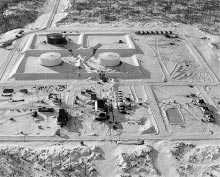 The Pembina Pipeline system was constructed in 1954 to transport crude oil from the Pembina field near Drayton Valley, Alberta to Edmonton, Alberta. The Pembina system serves one of the oldest oil-producing areas in Alberta.
The Pembina Pipeline system was constructed in 1954 to transport crude oil from the Pembina field near Drayton Valley, Alberta to Edmonton, Alberta. The Pembina system serves one of the oldest oil-producing areas in Alberta.
 The Pembina Pipeline system was constructed in 1954 to transport crude oil from the Pembina field near Drayton Valley, Alberta to Edmonton, Alberta. The Pembina system serves one of the oldest oil-producing areas in Alberta.
The Pembina Pipeline system was constructed in 1954 to transport crude oil from the Pembina field near Drayton Valley, Alberta to Edmonton, Alberta. The Pembina system serves one of the oldest oil-producing areas in Alberta.
1959
The Largest Dragline in Canada
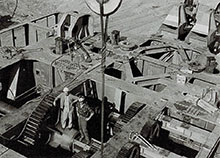 The new Ransomes & Rapier 1350-W dragline at the Whitewood Mine is assembled by a 45-member Mannix team in six months. When completed, it will be the largest dragline in Canada.
The new Ransomes & Rapier 1350-W dragline at the Whitewood Mine is assembled by a 45-member Mannix team in six months. When completed, it will be the largest dragline in Canada.
 The new Ransomes & Rapier 1350-W dragline at the Whitewood Mine is assembled by a 45-member Mannix team in six months. When completed, it will be the largest dragline in Canada.
The new Ransomes & Rapier 1350-W dragline at the Whitewood Mine is assembled by a 45-member Mannix team in six months. When completed, it will be the largest dragline in Canada.
1959
Keeping Canada Safe
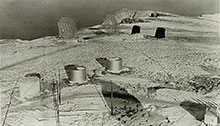 The Distant Early Warning (DEW) line in the Arctic Circle was part of a mutual defense agreement between Canada and the USA. It was devised to protect North America from air or missile attack. Mannix Co. Ltd. won the contract for general building construction and building of the steel parabolic reflectors intended to keep Canadians safe from potential Soviet bombers during the Cold War.
The Distant Early Warning (DEW) line in the Arctic Circle was part of a mutual defense agreement between Canada and the USA. It was devised to protect North America from air or missile attack. Mannix Co. Ltd. won the contract for general building construction and building of the steel parabolic reflectors intended to keep Canadians safe from potential Soviet bombers during the Cold War.
 The Distant Early Warning (DEW) line in the Arctic Circle was part of a mutual defense agreement between Canada and the USA. It was devised to protect North America from air or missile attack. Mannix Co. Ltd. won the contract for general building construction and building of the steel parabolic reflectors intended to keep Canadians safe from potential Soviet bombers during the Cold War.
The Distant Early Warning (DEW) line in the Arctic Circle was part of a mutual defense agreement between Canada and the USA. It was devised to protect North America from air or missile attack. Mannix Co. Ltd. won the contract for general building construction and building of the steel parabolic reflectors intended to keep Canadians safe from potential Soviet bombers during the Cold War.
1960
Alberta’s Largest Hydroelectric Project
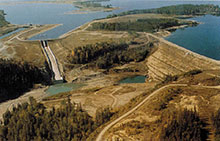 Calgary Power Ltd. and Mannix Co. Ltd begin the Brazeau hydro development in the Rocky Mountains southwest of Edmonton. When completed it will be Alberta’s largest single hydroelectric and water control project.
Calgary Power Ltd. and Mannix Co. Ltd begin the Brazeau hydro development in the Rocky Mountains southwest of Edmonton. When completed it will be Alberta’s largest single hydroelectric and water control project.
 Calgary Power Ltd. and Mannix Co. Ltd begin the Brazeau hydro development in the Rocky Mountains southwest of Edmonton. When completed it will be Alberta’s largest single hydroelectric and water control project.
Calgary Power Ltd. and Mannix Co. Ltd begin the Brazeau hydro development in the Rocky Mountains southwest of Edmonton. When completed it will be Alberta’s largest single hydroelectric and water control project.
1961
Building a Foundation for Manitoba Hydro
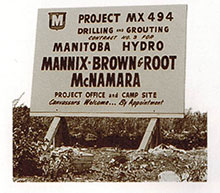 A Mannix Co. Ltd. sponsored joint venture begins the $10.7-million, two-year Grand Rapids grouting project to prepare a dam foundation for Manitoba Hydro.
A Mannix Co. Ltd. sponsored joint venture begins the $10.7-million, two-year Grand Rapids grouting project to prepare a dam foundation for Manitoba Hydro.
 A Mannix Co. Ltd. sponsored joint venture begins the $10.7-million, two-year Grand Rapids grouting project to prepare a dam foundation for Manitoba Hydro.
A Mannix Co. Ltd. sponsored joint venture begins the $10.7-million, two-year Grand Rapids grouting project to prepare a dam foundation for Manitoba Hydro.
1962
The Portage Mountain Diversion Tunnels
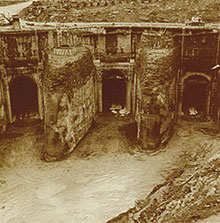 The Portage Mountain Diversion Tunnels are built for B.C. Hydro & Power Authority some 500 miles (800 kilometers) north of Vancouver, British Columbia. The Drake, Mannix, Kaiser and Gilpin joint venture builds the massive tunnels in only nine months.
The Portage Mountain Diversion Tunnels are built for B.C. Hydro & Power Authority some 500 miles (800 kilometers) north of Vancouver, British Columbia. The Drake, Mannix, Kaiser and Gilpin joint venture builds the massive tunnels in only nine months.
 The Portage Mountain Diversion Tunnels are built for B.C. Hydro & Power Authority some 500 miles (800 kilometers) north of Vancouver, British Columbia. The Drake, Mannix, Kaiser and Gilpin joint venture builds the massive tunnels in only nine months.
The Portage Mountain Diversion Tunnels are built for B.C. Hydro & Power Authority some 500 miles (800 kilometers) north of Vancouver, British Columbia. The Drake, Mannix, Kaiser and Gilpin joint venture builds the massive tunnels in only nine months.
1963
Supporting Canadian National Railways
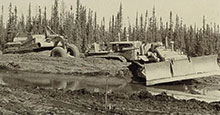 Mannix Highway Division crews grade right-of-way on the original Great Slave Lake Railway line for the Canadian National Railways. The work is called the Pine Point Grading.
Mannix Highway Division crews grade right-of-way on the original Great Slave Lake Railway line for the Canadian National Railways. The work is called the Pine Point Grading.
 Mannix Highway Division crews grade right-of-way on the original Great Slave Lake Railway line for the Canadian National Railways. The work is called the Pine Point Grading.
Mannix Highway Division crews grade right-of-way on the original Great Slave Lake Railway line for the Canadian National Railways. The work is called the Pine Point Grading.
1964
Reaching New Sources of Energy
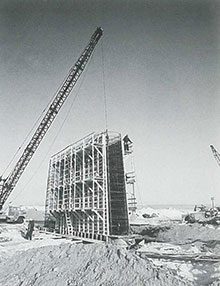 To reach the oil sands deposits, Mannix crews build a road from Fort McMurray, including a bridge across the Athabasca River, using many reinforced concrete supports.
To reach the oil sands deposits, Mannix crews build a road from Fort McMurray, including a bridge across the Athabasca River, using many reinforced concrete supports.
 To reach the oil sands deposits, Mannix crews build a road from Fort McMurray, including a bridge across the Athabasca River, using many reinforced concrete supports.
To reach the oil sands deposits, Mannix crews build a road from Fort McMurray, including a bridge across the Athabasca River, using many reinforced concrete supports.
1964
The First Hydro Development of the Columbia River
 Mannix Co. Ltd. sponsors a joint venture for B.C. Hydro & Power Authority to build the Duncan Dam, the first hydro development of the Columbia River in Canada. This $16-million project runs to 1967.
Mannix Co. Ltd. sponsors a joint venture for B.C. Hydro & Power Authority to build the Duncan Dam, the first hydro development of the Columbia River in Canada. This $16-million project runs to 1967.
 Mannix Co. Ltd. sponsors a joint venture for B.C. Hydro & Power Authority to build the Duncan Dam, the first hydro development of the Columbia River in Canada. This $16-million project runs to 1967.
Mannix Co. Ltd. sponsors a joint venture for B.C. Hydro & Power Authority to build the Duncan Dam, the first hydro development of the Columbia River in Canada. This $16-million project runs to 1967.
1964
Building the Montreal Subway
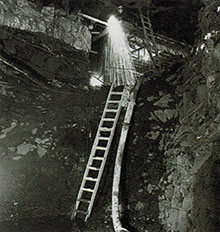 Joint venture partners Henry J. Kaiser Co. (Canada) and Mannix Co. Ltd. construct the Montreal Subway. This $4.7-million project runs from August 1964, to January 1966 and is operational for Expo 67.
Joint venture partners Henry J. Kaiser Co. (Canada) and Mannix Co. Ltd. construct the Montreal Subway. This $4.7-million project runs from August 1964, to January 1966 and is operational for Expo 67.
 Joint venture partners Henry J. Kaiser Co. (Canada) and Mannix Co. Ltd. construct the Montreal Subway. This $4.7-million project runs from August 1964, to January 1966 and is operational for Expo 67.
Joint venture partners Henry J. Kaiser Co. (Canada) and Mannix Co. Ltd. construct the Montreal Subway. This $4.7-million project runs from August 1964, to January 1966 and is operational for Expo 67.
1965
Generating Power for British Columbia
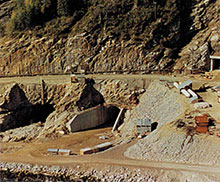 Joint venture partners Perini Pacific Limited, Northern Construction, J.W. Stewart Ltd., Mannix Co. Ltd. and Morrison-Knudsen construction of the 45-foot-high (13.7-meter) Mica Creek diversion tunnels for B.C. Hydro. The tunnels were the first step in the eventual construction of the Mica Creek Dam which today generates 1805 megawatts of power for BC.
Joint venture partners Perini Pacific Limited, Northern Construction, J.W. Stewart Ltd., Mannix Co. Ltd. and Morrison-Knudsen construction of the 45-foot-high (13.7-meter) Mica Creek diversion tunnels for B.C. Hydro. The tunnels were the first step in the eventual construction of the Mica Creek Dam which today generates 1805 megawatts of power for BC.
 Joint venture partners Perini Pacific Limited, Northern Construction, J.W. Stewart Ltd., Mannix Co. Ltd. and Morrison-Knudsen construction of the 45-foot-high (13.7-meter) Mica Creek diversion tunnels for B.C. Hydro. The tunnels were the first step in the eventual construction of the Mica Creek Dam which today generates 1805 megawatts of power for BC.
Joint venture partners Perini Pacific Limited, Northern Construction, J.W. Stewart Ltd., Mannix Co. Ltd. and Morrison-Knudsen construction of the 45-foot-high (13.7-meter) Mica Creek diversion tunnels for B.C. Hydro. The tunnels were the first step in the eventual construction of the Mica Creek Dam which today generates 1805 megawatts of power for BC.
1969
Resource Transportation Near Jasper National Park
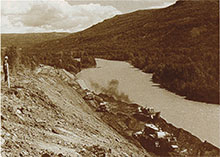 La Cie Mannix (Québec) Ltée., the Mannix Quebec subsidiary, completes the Alberta Resources Railway from near Jasper National Park to Grande Prairie, Alberta. This railway allowed previously undeveloped resources (because of the lack of transportation) to be developed.
La Cie Mannix (Québec) Ltée., the Mannix Quebec subsidiary, completes the Alberta Resources Railway from near Jasper National Park to Grande Prairie, Alberta. This railway allowed previously undeveloped resources (because of the lack of transportation) to be developed.
 La Cie Mannix (Québec) Ltée., the Mannix Quebec subsidiary, completes the Alberta Resources Railway from near Jasper National Park to Grande Prairie, Alberta. This railway allowed previously undeveloped resources (because of the lack of transportation) to be developed.
La Cie Mannix (Québec) Ltée., the Mannix Quebec subsidiary, completes the Alberta Resources Railway from near Jasper National Park to Grande Prairie, Alberta. This railway allowed previously undeveloped resources (because of the lack of transportation) to be developed.
1971
The Largest Single-Site Power Producer in the World
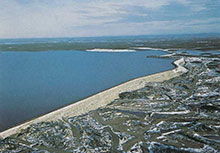 Mannix Co. Ltd.'s involvement in what surely must be, to this day, one of the most ambitious construction projects ever attempted by humans. Designed to harness the massive hydroelectric power of the Labrador plateau, the Churchill Falls development project was projected to generate a staggering seven million horsepower.
Mannix Co. Ltd.'s involvement in what surely must be, to this day, one of the most ambitious construction projects ever attempted by humans. Designed to harness the massive hydroelectric power of the Labrador plateau, the Churchill Falls development project was projected to generate a staggering seven million horsepower.
 Mannix Co. Ltd.'s involvement in what surely must be, to this day, one of the most ambitious construction projects ever attempted by humans. Designed to harness the massive hydroelectric power of the Labrador plateau, the Churchill Falls development project was projected to generate a staggering seven million horsepower.
Mannix Co. Ltd.'s involvement in what surely must be, to this day, one of the most ambitious construction projects ever attempted by humans. Designed to harness the massive hydroelectric power of the Labrador plateau, the Churchill Falls development project was projected to generate a staggering seven million horsepower.
1972
Keeping Canada Moving
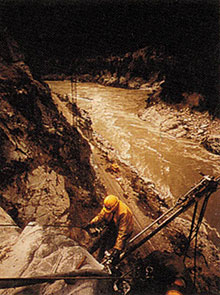 In British Columbia’s Fraser River Canyon, the CNR suffers from rock falling from cliffs above the tracks. Mannix Co. Ltd. provides rock bolts, hydraulic scaling and sprayed concrete (shotcrete), to solve the problem.
In British Columbia’s Fraser River Canyon, the CNR suffers from rock falling from cliffs above the tracks. Mannix Co. Ltd. provides rock bolts, hydraulic scaling and sprayed concrete (shotcrete), to solve the problem.
 In British Columbia’s Fraser River Canyon, the CNR suffers from rock falling from cliffs above the tracks. Mannix Co. Ltd. provides rock bolts, hydraulic scaling and sprayed concrete (shotcrete), to solve the problem.
In British Columbia’s Fraser River Canyon, the CNR suffers from rock falling from cliffs above the tracks. Mannix Co. Ltd. provides rock bolts, hydraulic scaling and sprayed concrete (shotcrete), to solve the problem.
1973
A Massive Canal System for Manitoba Hydro
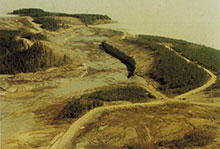 A Mannix-sponsored joint venture builds a massive canal system to divert Churchill River water to the Nelson River for Manitoba Hydro. The $28-million South Bay Channel Diversion project runs until 1976.
A Mannix-sponsored joint venture builds a massive canal system to divert Churchill River water to the Nelson River for Manitoba Hydro. The $28-million South Bay Channel Diversion project runs until 1976.
 A Mannix-sponsored joint venture builds a massive canal system to divert Churchill River water to the Nelson River for Manitoba Hydro. The $28-million South Bay Channel Diversion project runs until 1976.
A Mannix-sponsored joint venture builds a massive canal system to divert Churchill River water to the Nelson River for Manitoba Hydro. The $28-million South Bay Channel Diversion project runs until 1976.
1973
Meeting Increasing Demands for Electricity
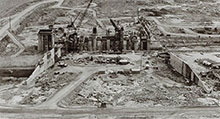 The Long Spruce generating station-a dam, spillway and powerhouse-is built on the Nelson River to help meet the increasing demand for electricity. Mannix Co. Ltd. helps construct this $102-million facility.
The Long Spruce generating station-a dam, spillway and powerhouse-is built on the Nelson River to help meet the increasing demand for electricity. Mannix Co. Ltd. helps construct this $102-million facility.
 The Long Spruce generating station-a dam, spillway and powerhouse-is built on the Nelson River to help meet the increasing demand for electricity. Mannix Co. Ltd. helps construct this $102-million facility.
The Long Spruce generating station-a dam, spillway and powerhouse-is built on the Nelson River to help meet the increasing demand for electricity. Mannix Co. Ltd. helps construct this $102-million facility.
1976
Completing the TransCanada Pipeline Project
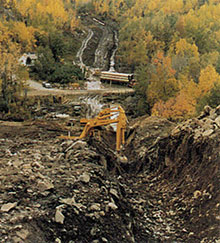 Loram International Ltd. completes the $3.6-million TransCanada Pipeline project near North Bay, Ontario.
Loram International Ltd. completes the $3.6-million TransCanada Pipeline project near North Bay, Ontario.
 Loram International Ltd. completes the $3.6-million TransCanada Pipeline project near North Bay, Ontario.
Loram International Ltd. completes the $3.6-million TransCanada Pipeline project near North Bay, Ontario.
1976
The Project of the Century
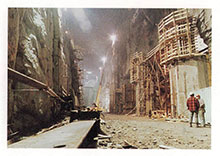 The Loram subsidiary, la Campagnie Loram (Quebec) Ltée., joint ventures with Komo in the five-year construction of the LG-2 West powerhouse for the James Bay Energy Corporation. Coined the “project of the century” the goal of the megaproject was to develop the extensive hydroelectric capabilities of the La Grande Rivière to provide an eventual 10,000 megawatts of power for Eastern Canada.
The Loram subsidiary, la Campagnie Loram (Quebec) Ltée., joint ventures with Komo in the five-year construction of the LG-2 West powerhouse for the James Bay Energy Corporation. Coined the “project of the century” the goal of the megaproject was to develop the extensive hydroelectric capabilities of the La Grande Rivière to provide an eventual 10,000 megawatts of power for Eastern Canada.
 The Loram subsidiary, la Campagnie Loram (Quebec) Ltée., joint ventures with Komo in the five-year construction of the LG-2 West powerhouse for the James Bay Energy Corporation. Coined the “project of the century” the goal of the megaproject was to develop the extensive hydroelectric capabilities of the La Grande Rivière to provide an eventual 10,000 megawatts of power for Eastern Canada.
The Loram subsidiary, la Campagnie Loram (Quebec) Ltée., joint ventures with Komo in the five-year construction of the LG-2 West powerhouse for the James Bay Energy Corporation. Coined the “project of the century” the goal of the megaproject was to develop the extensive hydroelectric capabilities of the La Grande Rivière to provide an eventual 10,000 megawatts of power for Eastern Canada.
1978
The Revelstoke Dam Powerhouse
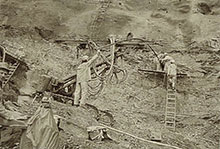 Loram International also excavates the site for the Revelstoke Dam powerhouse. More than 79,240 linear meters (86,600 yards) of rockbolts and dowels support and stabilize the back slope.
Loram International also excavates the site for the Revelstoke Dam powerhouse. More than 79,240 linear meters (86,600 yards) of rockbolts and dowels support and stabilize the back slope.
 Loram International also excavates the site for the Revelstoke Dam powerhouse. More than 79,240 linear meters (86,600 yards) of rockbolts and dowels support and stabilize the back slope.
Loram International also excavates the site for the Revelstoke Dam powerhouse. More than 79,240 linear meters (86,600 yards) of rockbolts and dowels support and stabilize the back slope.
1978
Providing Transportation for the Commonwealth Games
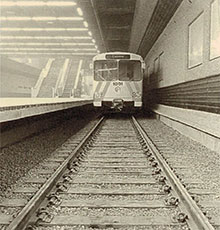 Edmonton’s new rapid transit system is a complete success during the Commonwealth Games held in August. The 14 kilometres (nine miles) of above and underground track are laid by the Railroad Division of Loram International.
Edmonton’s new rapid transit system is a complete success during the Commonwealth Games held in August. The 14 kilometres (nine miles) of above and underground track are laid by the Railroad Division of Loram International.
 Edmonton’s new rapid transit system is a complete success during the Commonwealth Games held in August. The 14 kilometres (nine miles) of above and underground track are laid by the Railroad Division of Loram International.
Edmonton’s new rapid transit system is a complete success during the Commonwealth Games held in August. The 14 kilometres (nine miles) of above and underground track are laid by the Railroad Division of Loram International.
1979
Introducing New Machinery into Canada
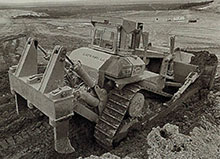 This D-10 Cat is one of the first three brought into Canada. Loram International use it on the $11.3-million Gibraltar Mines Limited stripping project near McLeese Lake, British Columbia. The project exposes a copper ore body.
This D-10 Cat is one of the first three brought into Canada. Loram International use it on the $11.3-million Gibraltar Mines Limited stripping project near McLeese Lake, British Columbia. The project exposes a copper ore body.
 This D-10 Cat is one of the first three brought into Canada. Loram International use it on the $11.3-million Gibraltar Mines Limited stripping project near McLeese Lake, British Columbia. The project exposes a copper ore body.
This D-10 Cat is one of the first three brought into Canada. Loram International use it on the $11.3-million Gibraltar Mines Limited stripping project near McLeese Lake, British Columbia. The project exposes a copper ore body.
1979
Working with TransCanada Pipelines
 Loram pipeline crews complete the Regina split casings work for TransCanada Pipelines.
Loram pipeline crews complete the Regina split casings work for TransCanada Pipelines.
 Loram pipeline crews complete the Regina split casings work for TransCanada Pipelines.
Loram pipeline crews complete the Regina split casings work for TransCanada Pipelines.
1982
Expanding Northern Resources
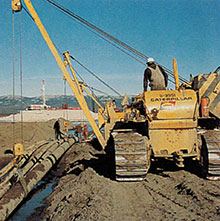 Based in part on prior Techman research, the Norman Wells project begins for Esso Resources Ltd. in the Northwest Territories. Here a Loram pipeline crew lays pipe to the artificial island built in the Mackenzie River. The island protects Esso Resources’ well.
Based in part on prior Techman research, the Norman Wells project begins for Esso Resources Ltd. in the Northwest Territories. Here a Loram pipeline crew lays pipe to the artificial island built in the Mackenzie River. The island protects Esso Resources’ well.
 Based in part on prior Techman research, the Norman Wells project begins for Esso Resources Ltd. in the Northwest Territories. Here a Loram pipeline crew lays pipe to the artificial island built in the Mackenzie River. The island protects Esso Resources’ well.
Based in part on prior Techman research, the Norman Wells project begins for Esso Resources Ltd. in the Northwest Territories. Here a Loram pipeline crew lays pipe to the artificial island built in the Mackenzie River. The island protects Esso Resources’ well.
1982
Continuing the Revelstoke Dam
 B.C. Hydro & Power Authority awards Loram a $53-million contract to supply and install the mechanical and electrical equipment for the Revelstoke Dam and powerhouse, spillway and switchgear building. Shown is the bus tunnel from the switchgear building.
B.C. Hydro & Power Authority awards Loram a $53-million contract to supply and install the mechanical and electrical equipment for the Revelstoke Dam and powerhouse, spillway and switchgear building. Shown is the bus tunnel from the switchgear building.
 B.C. Hydro & Power Authority awards Loram a $53-million contract to supply and install the mechanical and electrical equipment for the Revelstoke Dam and powerhouse, spillway and switchgear building. Shown is the bus tunnel from the switchgear building.
B.C. Hydro & Power Authority awards Loram a $53-million contract to supply and install the mechanical and electrical equipment for the Revelstoke Dam and powerhouse, spillway and switchgear building. Shown is the bus tunnel from the switchgear building.
1982
Gemini Corporation
 Gemini Corporation is founded by Mr. Carl Johnson. Gemini is an Alberta-based oil and gas services company focused on fabrication, engineering, construction and maintenance.
Gemini Corporation is founded by Mr. Carl Johnson. Gemini is an Alberta-based oil and gas services company focused on fabrication, engineering, construction and maintenance.
 Gemini Corporation is founded by Mr. Carl Johnson. Gemini is an Alberta-based oil and gas services company focused on fabrication, engineering, construction and maintenance.
Gemini Corporation is founded by Mr. Carl Johnson. Gemini is an Alberta-based oil and gas services company focused on fabrication, engineering, construction and maintenance.
1983
Linking British Columbia Roads
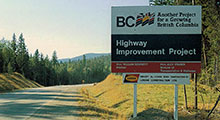 Loram Construction builds the Little Fort Highway (also known as Highway 24) to link Highway No. 5 with the Cariboo Highway in British Columbia.
Loram Construction builds the Little Fort Highway (also known as Highway 24) to link Highway No. 5 with the Cariboo Highway in British Columbia.
 Loram Construction builds the Little Fort Highway (also known as Highway 24) to link Highway No. 5 with the Cariboo Highway in British Columbia.
Loram Construction builds the Little Fort Highway (also known as Highway 24) to link Highway No. 5 with the Cariboo Highway in British Columbia.
1985
Tonko
 Tonko Realty Advisors Ltd., though its predecessor companies, provided fully integrated commercial real estate advisory and management services to major institutional and private investors in Western Canada for over 20 years.
Tonko Realty Advisors Ltd., though its predecessor companies, provided fully integrated commercial real estate advisory and management services to major institutional and private investors in Western Canada for over 20 years.
In 1985, Copez Realty Advisors Ltd. (“Copez”) was founded to offer asset and property management services to pension funds and private clients. In 1995, Tonko Development Corp. (TDC) was incorporated and listed on the TSX Venture Exchange. TDC expansion continued with the acquisition of Copez and Novam Development Ltd. in 1998.
 Tonko Realty Advisors Ltd., though its predecessor companies, provided fully integrated commercial real estate advisory and management services to major institutional and private investors in Western Canada for over 20 years.
Tonko Realty Advisors Ltd., though its predecessor companies, provided fully integrated commercial real estate advisory and management services to major institutional and private investors in Western Canada for over 20 years.In 1985, Copez Realty Advisors Ltd. (“Copez”) was founded to offer asset and property management services to pension funds and private clients. In 1995, Tonko Development Corp. (TDC) was incorporated and listed on the TSX Venture Exchange. TDC expansion continued with the acquisition of Copez and Novam Development Ltd. in 1998.
1988
Supporting the 1988 Calgary Olympics
 More than 130 Loram Group employees volunteer, as members of Team Petroleum, to support the Calgary Winter Olympic Games.
More than 130 Loram Group employees volunteer, as members of Team Petroleum, to support the Calgary Winter Olympic Games.
 More than 130 Loram Group employees volunteer, as members of Team Petroleum, to support the Calgary Winter Olympic Games.
More than 130 Loram Group employees volunteer, as members of Team Petroleum, to support the Calgary Winter Olympic Games.
1989
A Canadian Senator
 Former Loram executive Stan Waters becomes Canada’s first elected senator.
Former Loram executive Stan Waters becomes Canada’s first elected senator.
 Former Loram executive Stan Waters becomes Canada’s first elected senator.
Former Loram executive Stan Waters becomes Canada’s first elected senator.
1991
Producing Oil and Gas in the Prairies
 Pembina’s pipeline interests are significantly expanded with the acquisition of the Peace Pipeline system which serves as a producer in oil and gas fields in northwestern Alberta and northeastern British Columbia.
Pembina’s pipeline interests are significantly expanded with the acquisition of the Peace Pipeline system which serves as a producer in oil and gas fields in northwestern Alberta and northeastern British Columbia.
 Pembina’s pipeline interests are significantly expanded with the acquisition of the Peace Pipeline system which serves as a producer in oil and gas fields in northwestern Alberta and northeastern British Columbia.
Pembina’s pipeline interests are significantly expanded with the acquisition of the Peace Pipeline system which serves as a producer in oil and gas fields in northwestern Alberta and northeastern British Columbia.
1991
Moving Alberta’s Energy Resources
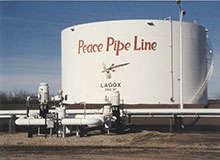 The Peace Pipeline System is one of the largest feed sources of oil, condensate and natural gas liquids in Alberta. It owned and operated more than 2,200 kilometers of pipeline with connections to 49 oil fields and 17 gas plants.
The Peace Pipeline System is one of the largest feed sources of oil, condensate and natural gas liquids in Alberta. It owned and operated more than 2,200 kilometers of pipeline with connections to 49 oil fields and 17 gas plants.
 The Peace Pipeline System is one of the largest feed sources of oil, condensate and natural gas liquids in Alberta. It owned and operated more than 2,200 kilometers of pipeline with connections to 49 oil fields and 17 gas plants.
The Peace Pipeline System is one of the largest feed sources of oil, condensate and natural gas liquids in Alberta. It owned and operated more than 2,200 kilometers of pipeline with connections to 49 oil fields and 17 gas plants.
1993
Raising Money for the United Way
 Loram Maintenance of Way Inc., raises the highest dollar figure in its history of United Way campaigns, totaling pledges of $35,505.
Loram Maintenance of Way Inc., raises the highest dollar figure in its history of United Way campaigns, totaling pledges of $35,505.
 Loram Maintenance of Way Inc., raises the highest dollar figure in its history of United Way campaigns, totaling pledges of $35,505.
Loram Maintenance of Way Inc., raises the highest dollar figure in its history of United Way campaigns, totaling pledges of $35,505.
1994
A Major Player in the Oil and Gas Industry
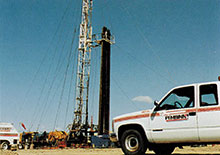 Pembina celebrates its 40th anniversary. The company is a senior Canadian oil and gas producer, Alberta’s largest owner/operator of crude oil and liquids feeder pipelines and is the largest oil and gas producer in Ontario.
Pembina celebrates its 40th anniversary. The company is a senior Canadian oil and gas producer, Alberta’s largest owner/operator of crude oil and liquids feeder pipelines and is the largest oil and gas producer in Ontario.
 Pembina celebrates its 40th anniversary. The company is a senior Canadian oil and gas producer, Alberta’s largest owner/operator of crude oil and liquids feeder pipelines and is the largest oil and gas producer in Ontario.
Pembina celebrates its 40th anniversary. The company is a senior Canadian oil and gas producer, Alberta’s largest owner/operator of crude oil and liquids feeder pipelines and is the largest oil and gas producer in Ontario.
1995
Redcliff
 Emerald Properties Inc., a property management company, was established in 1995 and later renamed Redcliff Realty Management Inc. (RRMI).
Emerald Properties Inc., a property management company, was established in 1995 and later renamed Redcliff Realty Management Inc. (RRMI).
The advisory arm began its business in 1976 as a unit of Royal Trust. It was subsequently named RT Realty Advisors Inc. and it became a subsidiary of the Royal Bank Financial Group in 1993. RT Realty Advisors was purchased in 2001 by Redcliff Realty Management Inc. to take advantage of its real estate knowledge and experience, and to help achieve the objectives of building a full-service real estate advisory group. With this acquisition, Redcliff Realty Group Corp. (RRGC) was formed in 2002.
Under RRGC, the company structured three entities - Redcliff Realty Advisors Inc. and Redcliff Realty Management Inc. A third licensed mortgage brokerage entity was later formed called Redcliff Realty Capital.
 Emerald Properties Inc., a property management company, was established in 1995 and later renamed Redcliff Realty Management Inc. (RRMI).
Emerald Properties Inc., a property management company, was established in 1995 and later renamed Redcliff Realty Management Inc. (RRMI).The advisory arm began its business in 1976 as a unit of Royal Trust. It was subsequently named RT Realty Advisors Inc. and it became a subsidiary of the Royal Bank Financial Group in 1993. RT Realty Advisors was purchased in 2001 by Redcliff Realty Management Inc. to take advantage of its real estate knowledge and experience, and to help achieve the objectives of building a full-service real estate advisory group. With this acquisition, Redcliff Realty Group Corp. (RRGC) was formed in 2002.
Under RRGC, the company structured three entities - Redcliff Realty Advisors Inc. and Redcliff Realty Management Inc. A third licensed mortgage brokerage entity was later formed called Redcliff Realty Capital.
1997
Sale of Energy Assets
 A decision was made to divest most of the Group’s energy assets. Manalta Coal, Pembina Pipeline, and Pembina Resources were sold to the public markets via an income trust, a royalty trust and an asset sale respectively.
A decision was made to divest most of the Group’s energy assets. Manalta Coal, Pembina Pipeline, and Pembina Resources were sold to the public markets via an income trust, a royalty trust and an asset sale respectively.
Mr. Ron Mannix then established Coril Holdings Ltd. to continue the railroad activities and pursue real estate and other investments.
 A decision was made to divest most of the Group’s energy assets. Manalta Coal, Pembina Pipeline, and Pembina Resources were sold to the public markets via an income trust, a royalty trust and an asset sale respectively.
A decision was made to divest most of the Group’s energy assets. Manalta Coal, Pembina Pipeline, and Pembina Resources were sold to the public markets via an income trust, a royalty trust and an asset sale respectively. Mr. Ron Mannix then established Coril Holdings Ltd. to continue the railroad activities and pursue real estate and other investments.
2000
A New Calgary Hotel
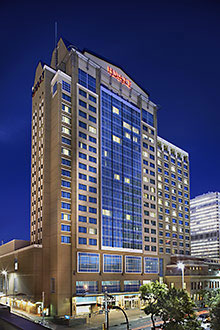 Balboa Land Investments, under the direction of Mr. Randy Provost as President and CEO, Mr Kevin Beingessner, as Senior Vice President, and Mr. Henry Neufeld as General Manager, is involved in the real estate business, owning and managing properties in Alberta. They open the new Hyatt Regency Hotel in downtown Calgary.
Balboa Land Investments, under the direction of Mr. Randy Provost as President and CEO, Mr Kevin Beingessner, as Senior Vice President, and Mr. Henry Neufeld as General Manager, is involved in the real estate business, owning and managing properties in Alberta. They open the new Hyatt Regency Hotel in downtown Calgary.
 Balboa Land Investments, under the direction of Mr. Randy Provost as President and CEO, Mr Kevin Beingessner, as Senior Vice President, and Mr. Henry Neufeld as General Manager, is involved in the real estate business, owning and managing properties in Alberta. They open the new Hyatt Regency Hotel in downtown Calgary.
Balboa Land Investments, under the direction of Mr. Randy Provost as President and CEO, Mr Kevin Beingessner, as Senior Vice President, and Mr. Henry Neufeld as General Manager, is involved in the real estate business, owning and managing properties in Alberta. They open the new Hyatt Regency Hotel in downtown Calgary.
2001
Tonko
 Tonko Development Corp was taken private and rebranded as Tonko Realty Advisors.
Tonko Development Corp was taken private and rebranded as Tonko Realty Advisors.
 Tonko Development Corp was taken private and rebranded as Tonko Realty Advisors.
Tonko Development Corp was taken private and rebranded as Tonko Realty Advisors.
2007
A Historic Landmark
 In 1891, as business moved toward downtown, a new frame structure was started on Stephen Avenue. The sandstone structure, known as The Hudson Block, was initially built for the third Hudson’s Bay Store. In 1905 the store expanded to include the site of James Lougheed’s former home and law offices. The site was sold to the Royal Bank in 1912, and restored by the Royal Bank in 1977, and designated a Provincial Historic Resource in 1982. In April of 2005 Balboa purchased the building as part of a strategic plan to acquire the southeast quarter to allow an adequate amount of contiguous land for potential office/retail development or, alternatively, expansion of the Hyatt Hotel.
In 1891, as business moved toward downtown, a new frame structure was started on Stephen Avenue. The sandstone structure, known as The Hudson Block, was initially built for the third Hudson’s Bay Store. In 1905 the store expanded to include the site of James Lougheed’s former home and law offices. The site was sold to the Royal Bank in 1912, and restored by the Royal Bank in 1977, and designated a Provincial Historic Resource in 1982. In April of 2005 Balboa purchased the building as part of a strategic plan to acquire the southeast quarter to allow an adequate amount of contiguous land for potential office/retail development or, alternatively, expansion of the Hyatt Hotel.
 In 1891, as business moved toward downtown, a new frame structure was started on Stephen Avenue. The sandstone structure, known as The Hudson Block, was initially built for the third Hudson’s Bay Store. In 1905 the store expanded to include the site of James Lougheed’s former home and law offices. The site was sold to the Royal Bank in 1912, and restored by the Royal Bank in 1977, and designated a Provincial Historic Resource in 1982. In April of 2005 Balboa purchased the building as part of a strategic plan to acquire the southeast quarter to allow an adequate amount of contiguous land for potential office/retail development or, alternatively, expansion of the Hyatt Hotel.
In 1891, as business moved toward downtown, a new frame structure was started on Stephen Avenue. The sandstone structure, known as The Hudson Block, was initially built for the third Hudson’s Bay Store. In 1905 the store expanded to include the site of James Lougheed’s former home and law offices. The site was sold to the Royal Bank in 1912, and restored by the Royal Bank in 1977, and designated a Provincial Historic Resource in 1982. In April of 2005 Balboa purchased the building as part of a strategic plan to acquire the southeast quarter to allow an adequate amount of contiguous land for potential office/retail development or, alternatively, expansion of the Hyatt Hotel.
2007
Redcliff
 Redcliff Realty Group Corp acquired Montreal-based Métivier and Associates. This acquisitions expanded Redcliff’s portfolio and coverage in Quebec.
Redcliff Realty Group Corp acquired Montreal-based Métivier and Associates. This acquisitions expanded Redcliff’s portfolio and coverage in Quebec.
Redcliff Realty Advisors provided acquisition, disposition, development, portfolio and asset management services. Redcliff Realty Management was responsible for the leasing and property management functions for the office, industrial and retail properties under its management. Redcliff Realty Capital Redcliff Realty Group was a wholly owned subsidiary of Osmington Inc., a real estate investment company, owned by David Thomson. During this period Osmington was a private Canadian real estate company that provides deal sourcing and the ability to co-invest with Redcliff clients.
 Redcliff Realty Group Corp acquired Montreal-based Métivier and Associates. This acquisitions expanded Redcliff’s portfolio and coverage in Quebec.
Redcliff Realty Group Corp acquired Montreal-based Métivier and Associates. This acquisitions expanded Redcliff’s portfolio and coverage in Quebec.Redcliff Realty Advisors provided acquisition, disposition, development, portfolio and asset management services. Redcliff Realty Management was responsible for the leasing and property management functions for the office, industrial and retail properties under its management. Redcliff Realty Capital Redcliff Realty Group was a wholly owned subsidiary of Osmington Inc., a real estate investment company, owned by David Thomson. During this period Osmington was a private Canadian real estate company that provides deal sourcing and the ability to co-invest with Redcliff clients.
2010
A Historical Building is Given New Life
 Cantos, working with Dr. Roger Jackson as Chairman, Andrew Mosker as President and CEO, and Ron Mannix as a Director, works on the redevelopment of the old King Eddy Hotel in East Calgary to create Canada’s National Music Centre. When complete, this cultural icon (a $130-million-dollar project) will be 110,000 square feet.
Cantos, working with Dr. Roger Jackson as Chairman, Andrew Mosker as President and CEO, and Ron Mannix as a Director, works on the redevelopment of the old King Eddy Hotel in East Calgary to create Canada’s National Music Centre. When complete, this cultural icon (a $130-million-dollar project) will be 110,000 square feet.
 Cantos, working with Dr. Roger Jackson as Chairman, Andrew Mosker as President and CEO, and Ron Mannix as a Director, works on the redevelopment of the old King Eddy Hotel in East Calgary to create Canada’s National Music Centre. When complete, this cultural icon (a $130-million-dollar project) will be 110,000 square feet.
Cantos, working with Dr. Roger Jackson as Chairman, Andrew Mosker as President and CEO, and Ron Mannix as a Director, works on the redevelopment of the old King Eddy Hotel in East Calgary to create Canada’s National Music Centre. When complete, this cultural icon (a $130-million-dollar project) will be 110,000 square feet.
2010
The Keynote Project
 The Keynote project, a 1.4-million-square-foot multi-use project next to the Stampede grounds, opens. Keynote is a mixed-use development which includes a 14-storey office tower, a 26-storey condominium tower and significant retail space, including a boutique grocery store.
The Keynote project, a 1.4-million-square-foot multi-use project next to the Stampede grounds, opens. Keynote is a mixed-use development which includes a 14-storey office tower, a 26-storey condominium tower and significant retail space, including a boutique grocery store.
 The Keynote project, a 1.4-million-square-foot multi-use project next to the Stampede grounds, opens. Keynote is a mixed-use development which includes a 14-storey office tower, a 26-storey condominium tower and significant retail space, including a boutique grocery store.
The Keynote project, a 1.4-million-square-foot multi-use project next to the Stampede grounds, opens. Keynote is a mixed-use development which includes a 14-storey office tower, a 26-storey condominium tower and significant retail space, including a boutique grocery store.
2010
A Focus on Health and Wellness
 One of Coril’s strategic focuses has been in the health and wellness industry with the purchase of Foothills Health Consultants in March 2008 and in December 2009 with the acquisition of Innovative Health Group to expand and further develop these initiatives The Company is rebranded as “INLIV” and prepares to move into new premises in the Arriva Tower in late 2011.
One of Coril’s strategic focuses has been in the health and wellness industry with the purchase of Foothills Health Consultants in March 2008 and in December 2009 with the acquisition of Innovative Health Group to expand and further develop these initiatives The Company is rebranded as “INLIV” and prepares to move into new premises in the Arriva Tower in late 2011.
 One of Coril’s strategic focuses has been in the health and wellness industry with the purchase of Foothills Health Consultants in March 2008 and in December 2009 with the acquisition of Innovative Health Group to expand and further develop these initiatives The Company is rebranded as “INLIV” and prepares to move into new premises in the Arriva Tower in late 2011.
One of Coril’s strategic focuses has been in the health and wellness industry with the purchase of Foothills Health Consultants in March 2008 and in December 2009 with the acquisition of Innovative Health Group to expand and further develop these initiatives The Company is rebranded as “INLIV” and prepares to move into new premises in the Arriva Tower in late 2011.
2011
The Ghost River Crossing
 Coril’s most recent acquisition, is a retreat and conference Centre with a 33 year history, located 30 minutes west of Calgary. The organization is committed to enhancing lives through connection - experiences based in nature, music, art, and relationships. Briefly owned by the Canadian Pacific Railway, The Ghost river crossing has served as an emblematic corporate retreat center to connect the visitors with nature. In the 1970’s is served as a retreat center, which has now developed in to a place where intentions and actions are uniform, as they are enveloped in the breath –taking scenery of the Alberta plains.
Coril’s most recent acquisition, is a retreat and conference Centre with a 33 year history, located 30 minutes west of Calgary. The organization is committed to enhancing lives through connection - experiences based in nature, music, art, and relationships. Briefly owned by the Canadian Pacific Railway, The Ghost river crossing has served as an emblematic corporate retreat center to connect the visitors with nature. In the 1970’s is served as a retreat center, which has now developed in to a place where intentions and actions are uniform, as they are enveloped in the breath –taking scenery of the Alberta plains.
 Coril’s most recent acquisition, is a retreat and conference Centre with a 33 year history, located 30 minutes west of Calgary. The organization is committed to enhancing lives through connection - experiences based in nature, music, art, and relationships. Briefly owned by the Canadian Pacific Railway, The Ghost river crossing has served as an emblematic corporate retreat center to connect the visitors with nature. In the 1970’s is served as a retreat center, which has now developed in to a place where intentions and actions are uniform, as they are enveloped in the breath –taking scenery of the Alberta plains.
Coril’s most recent acquisition, is a retreat and conference Centre with a 33 year history, located 30 minutes west of Calgary. The organization is committed to enhancing lives through connection - experiences based in nature, music, art, and relationships. Briefly owned by the Canadian Pacific Railway, The Ghost river crossing has served as an emblematic corporate retreat center to connect the visitors with nature. In the 1970’s is served as a retreat center, which has now developed in to a place where intentions and actions are uniform, as they are enveloped in the breath –taking scenery of the Alberta plains.
2011
Tonko
 Tonko Realty Advisors was acquired by Coril and began operating as a subsidiary of Balboa Investments Inc.
Tonko Realty Advisors was acquired by Coril and began operating as a subsidiary of Balboa Investments Inc.
 Tonko Realty Advisors was acquired by Coril and began operating as a subsidiary of Balboa Investments Inc.
Tonko Realty Advisors was acquired by Coril and began operating as a subsidiary of Balboa Investments Inc.
2012
Triovest
 Triovest represents the merger of Redcliff Realty Group Corp. and Calgary-based Tonko Realty Advisors Ltd. The two companies became unified in October 2011 when The Coril Group of Companies announce the acquisition of Redcliff. Coril had acquired Tonko in June 2011. As a result of the amalgamation, a national full service real estate company branded as Triovest Realty Advisors was created in June 2012.
Triovest represents the merger of Redcliff Realty Group Corp. and Calgary-based Tonko Realty Advisors Ltd. The two companies became unified in October 2011 when The Coril Group of Companies announce the acquisition of Redcliff. Coril had acquired Tonko in June 2011. As a result of the amalgamation, a national full service real estate company branded as Triovest Realty Advisors was created in June 2012.
 Triovest represents the merger of Redcliff Realty Group Corp. and Calgary-based Tonko Realty Advisors Ltd. The two companies became unified in October 2011 when The Coril Group of Companies announce the acquisition of Redcliff. Coril had acquired Tonko in June 2011. As a result of the amalgamation, a national full service real estate company branded as Triovest Realty Advisors was created in June 2012.
Triovest represents the merger of Redcliff Realty Group Corp. and Calgary-based Tonko Realty Advisors Ltd. The two companies became unified in October 2011 when The Coril Group of Companies announce the acquisition of Redcliff. Coril had acquired Tonko in June 2011. As a result of the amalgamation, a national full service real estate company branded as Triovest Realty Advisors was created in June 2012.
2012
Gemini Corporation
 Coril acquires a controlling position in Gemini Corporation, providing an opportunity for continued growth into the oil and gas infrastructure sector.
Coril acquires a controlling position in Gemini Corporation, providing an opportunity for continued growth into the oil and gas infrastructure sector.
 Coril acquires a controlling position in Gemini Corporation, providing an opportunity for continued growth into the oil and gas infrastructure sector.
Coril acquires a controlling position in Gemini Corporation, providing an opportunity for continued growth into the oil and gas infrastructure sector.
2014
Industrial Development in Montreal
 In the past year, Balboa expands its Calgary holdings with the strategic acquisition of key properties associated with its downtown and East Village land assemblies. Balboa also diversifies its operations into the Greater Montreal Area, by co-investing in a multi-phase industrial development in a partnership to be managed by Triovest. The industrial development in Montreal by Triovest is a strategic acquisition of major importance to Triovest as it is the first purchase made by Triovest. The Montreal industrial site occupies around 279 231 m^2(69 acres) as well as may offer around 120 774m^2 of industrial space.
In the past year, Balboa expands its Calgary holdings with the strategic acquisition of key properties associated with its downtown and East Village land assemblies. Balboa also diversifies its operations into the Greater Montreal Area, by co-investing in a multi-phase industrial development in a partnership to be managed by Triovest. The industrial development in Montreal by Triovest is a strategic acquisition of major importance to Triovest as it is the first purchase made by Triovest. The Montreal industrial site occupies around 279 231 m^2(69 acres) as well as may offer around 120 774m^2 of industrial space.
 In the past year, Balboa expands its Calgary holdings with the strategic acquisition of key properties associated with its downtown and East Village land assemblies. Balboa also diversifies its operations into the Greater Montreal Area, by co-investing in a multi-phase industrial development in a partnership to be managed by Triovest. The industrial development in Montreal by Triovest is a strategic acquisition of major importance to Triovest as it is the first purchase made by Triovest. The Montreal industrial site occupies around 279 231 m^2(69 acres) as well as may offer around 120 774m^2 of industrial space.
In the past year, Balboa expands its Calgary holdings with the strategic acquisition of key properties associated with its downtown and East Village land assemblies. Balboa also diversifies its operations into the Greater Montreal Area, by co-investing in a multi-phase industrial development in a partnership to be managed by Triovest. The industrial development in Montreal by Triovest is a strategic acquisition of major importance to Triovest as it is the first purchase made by Triovest. The Montreal industrial site occupies around 279 231 m^2(69 acres) as well as may offer around 120 774m^2 of industrial space.

